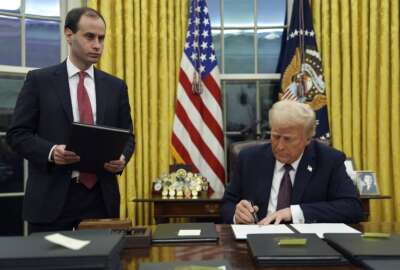
Implementing a Multi Cloud Strategy
Moving any enterprise to the cloud presents new challenges, particularly as data is moved off-premises. Over the last seven-plus years, agencies have faced many of...
Many agencies are finding that a hybrid or a multi-vendor cloud environment makes the most sense for them.
The General Services Administration said in a 2016 best practices for cloud guide that the hybrid or multi-vendor environment can rely on a broker model to federate applications, data, security and other services.
This means agencies need to adjust to new operational and managerial models, including the concept that security needs to move with the application no matter which commercial or government cloud it sits in and no matter how employees access the app and data whether from a laptop, desktop, tablet or mobile device.
The continued and ever-growing reliance on mobile devices also opens the door to the need for new thinking.
Through the use of orchestration and optimization, agencies can create a security model that fits their employees’ needs. And, of course, that leads agencies down the path toward thin clients or zero clients to better enable these devices while also keeping data and apps secure.
Experts say concepts like interoperability, the use of containers to ease portability and the development of micro-services also are key ingredients to a successful multi-vendor cloud effort.
Moderator
 Jason Miller
Jason Miller
Jason Miller is a reporter whose work focuses mainly on technology and procurement issues, including cybersecurity, e-government and acquisition policies and programs.
Panelists
 Daniel P. Corbin, Chief Technology Advisor, C4 Headquarters, U.S. Marine Corps
Daniel P. Corbin, Chief Technology Advisor, C4 Headquarters, U.S. Marine Corps
Mr. Corbin currently serves as the Chief Technology Advisor (CTA) of the Command, Control, Communications, and Computers (C4) Department at Headquarters Marine Corps. In this capacity, he provides advice for all matters pertaining to identification and validation of IT requirements, lead for continuing assessment and identification of promising emerging C4 and information technologies for exploitation and application in the war fighting and business domains.
 Randall Conway, Deputy CIO for Information Enterprise, Department of Defense
Randall Conway, Deputy CIO for Information Enterprise, Department of Defense
Mr. Randall G. Conway is a member of the Senior Executive Service (SES) and is currently serving as the Department of Defense Deputy Chief Information Officer for Information Enterprise (DCIO-IE). Mr. Conway has extensive experience in planning, training, operating, and managing communications and information technology systems, services, and applications within the Office of the Secretary of Defense, The Joint Staff, United States Army, Joint Operational Commands, and the MITRE Corporation.
As the DCIO-IE, Mr. Conway provides technical expertise, policy guidance, and leadership to drive OSD processes and actions to realize an integrated Department-wide implementation of the Joint Information Environment (JIE) and its two primary sub-components called the Joint Regional Security Stack (JRSS) and the Mission Partner Environment Information System (MPE-IS). Additionally, he leads the CIO priorities in the areas of cloud computing, architecture development, and enterprise services for the larger DoD Information Enterprise. He supervises the development of implementation plans, budgets, their execution, measurements, resourcing strategies, and ensures DoD-wide information technology standards are prescribed and enforced and recommends the elimination of duplicative IT systems within the DoD information environment.
 Larry Reed, Assistant Director for Security Operations, Department of Justice
Larry Reed, Assistant Director for Security Operations, Department of Justice
Mr. Reed joined the Department of Justice Office of the Chief Information Officer in 2016 as the Assistant Director for Security Operations. In this position, he is responsible for all aspect of security operations at the department level including the Justice Security Operations Center, the Insider Threat Prevention and Detection Program, and the Supply Chain Risk Management Program.
 Tom Sasala, Director of Operations and Architecture, Office of the CIO/G-6, U.S. Army
Tom Sasala, Director of Operations and Architecture, Office of the CIO/G-6, U.S. Army
Mr. Sasala serves as the Director of Operations and Architecture at the Headquarters, Department of the Army, Office of the Chief Information Officer (CIO)/G-6. As the Director, Mr. Sasala reports directly to the Army CIO/G-6. He is responsible for ensuring the interoperability and supportability of the Army’s Information Technology Architectures and leading the planning, development, and implementation of the Army’s Enterprise Architecture.
 Bill Rowan, Vice President of Federal Sales, VMware
Bill Rowan, Vice President of Federal Sales, VMware
Bill Rowan is Vice President of Federal Sales for VMware’s U.S. Public Sector organization. He leads a team of more than 175 sales, engineering, advisory and implementation services professionals who help Federal organizations meet their unique requirements with the application of virtualization, mobility and cloud technology.
Copyright © 2025 Federal News Network. All rights reserved. This website is not intended for users located within the European Economic Area.
Related Stories






